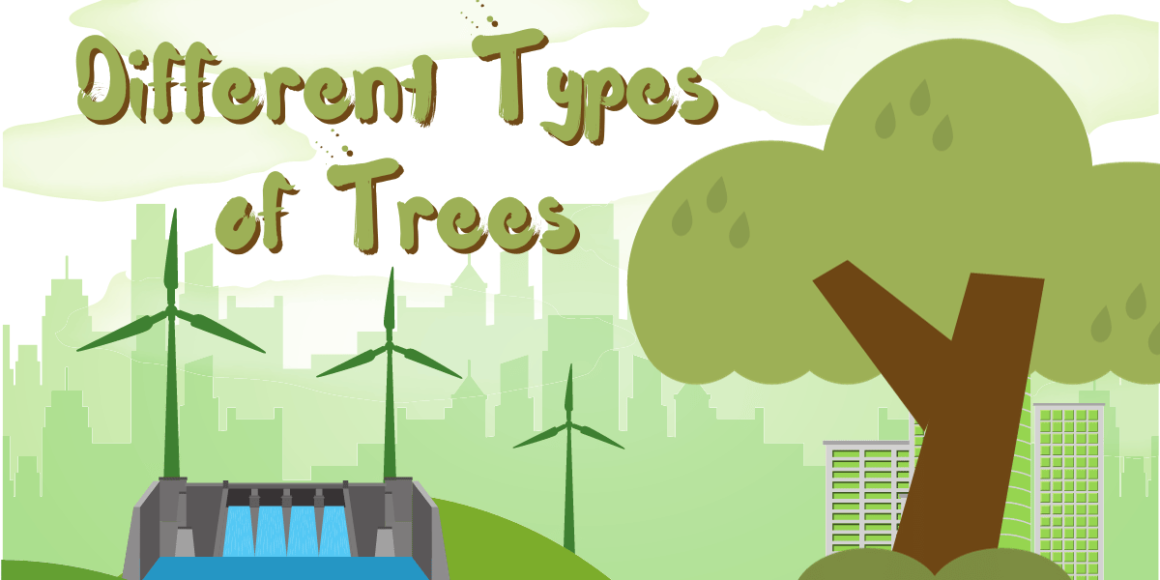
Welcome to our informative guide on different types of trees. Trees are not only essential for the environment but also, add beauty and serenity to our surroundings.
In this post, we will explore the names of different types of trees, characteristics, and importance of various types of trees.
Whether you are a nature lover or simply curious about the flora around you, this guide will provide you with valuable information on trees. Now, let’s start with a wonderful journey of the different types of trees.
Types of Trees and Their Names
Knowing the names of different types of trees can enrich your understanding of the natural world and help you appreciate the diversity of plant life. Here are some of the most common types of trees:
Oak Trees: Oak trees are known for their strength and longevity. With over 600 species worldwide, oak trees provide valuable hardwood and offer habitats for various wildlife.
| Specification | Description |
|---|---|
| Common Name | Oak Tree |
| Scientific Name | Quercus (Genus) |
| Various species, e.g., Quercus alba (White Oak) | |
| Height | Typically 50 to 100 feet (15 to 30 meters) |
| Lifespan | Can live for several hundred years |
| Foliage | Broad, deciduous leaves |
| Leaf Shape | Typically lobed, with pointed tips |
| Bark | Thick, rough, and furrowed |
| Acorns | Seed nuts produced by oak trees |
| Growth Rate | Moderate |
| Soil Type | Well-drained, fertile soil |
| Climate | Various climates, depending on species |
| Uses | Timber, furniture, flooring, landscaping |
| Wildlife Support | Provides habitat and food for various species |
| Notable Species | White Oak, Red Oak, English Oak, Bur Oak, etc. |
Maple Trees: Maple trees are renowned for their vibrant foliage, making them popular in autumn landscapes. These trees also produce syrup and have a wide range of uses in furniture and flooring.
| Specification | Description |
|---|---|
| Common Name | Maple Trees |
| Scientific Name | Acer spp. |
| Type | Deciduous |
| Average Height | Varies (typically 20-100 feet) |
| Leaf Shape | Palmate (hand-like) |
| Leaf Color | Green (changes to vibrant red, orange, or yellow in fall) |
| Bark Color | Brown to gray, often with vertical furrows or ridges |
| Flowers | Small, inconspicuous, usually in clusters |
| Fruit | Double-winged samaras (maple keys) |
| Growing Zones | Various, depending on the species |
| Soil Requirements | Well-drained, loamy soil |
| Sunlight | Full sun to partial shade |
| Watering Needs | Regular watering, especially during dry spells |
| Maintenance | Pruning for shape and health, removal of dead wood |
| Landscape Use | Shade trees, ornamental landscaping |
| Distinguishing Feature | Vibrant fall foliage |
Pine Trees: Pine trees are evergreen conifers that are found in diverse environments. They are known for their distinct pine cones and their versatile wood is used for construction, furniture, and paper production.
| Specification | Description |
|---|---|
| Common Name | Pine Trees |
| Scientific Name | Pinus (genus) |
| Average Height | Varies, typically 40 to 100 feet (12 to 30 meters) |
| Leaf Type | Needle-like leaves, arranged in clusters |
| Leaf Color | Green |
| Bark Color | Brown, often with a rough texture |
| Cone Type | Woody cones, typically cylindrical |
| Reproduction | Cones produce seeds that fall to the ground |
| Growth Rate | Moderate to fast |
| Preferred Soil Type | Well-drained, acidic soil |
| Climate | Adapted to various climates, often in colder regions |
| Uses | Timber, Christmas trees, landscaping |
| Common Species | Eastern White Pine, Scots Pine, Ponderosa Pine |
| Special Characteristics | Resinous sap, distinctive pine scent |
Birch Trees: Birch trees are known for their beautiful white bark and graceful appearance. They are commonly found in temperate regions and their wood is used for furniture, plywood, and paper.
| Specification | Description |
|---|---|
| Common Name | Birch Trees |
| Scientific Name | Betula spp. |
| Average Height | 40 to 70 feet (12 to 21 meters) |
| Bark Color | White, silver, or gray with distinctive horizontal lines |
| Leaves | Simple, serrated edges, alternate arrangement |
| Leaf Color | Green in spring and summer; yellow in fall |
| Flowers | Catkins, typically in spring |
| Soil Preferences | Well-drained, moist soil |
| Sunlight Requirements | Full to partial sunlight |
| Growth Rate | Moderate to fast |
| Lifespan | 40 to 50 years |
| Common Uses | Landscaping, furniture, paper production |
| Environmental Impact | Provides habitat for birds and insects; air purifying |
Spruce Trees: Spruce trees are another type of conifer that are highly valued for their timber. They have needle-like leaves and produce cones that house their seeds.
| Specification | Description |
|---|---|
| Common Name | Spruce Trees |
| Scientific Name | Picea spp. |
| Height | Varies by species, typically 20 to 200 feet (6 to 60 meters) |
| Bark | Thin, scaly or flaky, often gray-brown in color |
| Needles | Evergreen, needle-like leaves, arranged spirally on branches |
| Cone Type | Woody cones, typically pendulous, with thin scales |
| Growth Rate | Moderate to fast, depending on species and conditions |
| Soil Type | Well-drained, acidic soils preferred |
| Sunlight | Full to partial sunlight |
| Hardiness Zones | Varies by species, generally cold-hardy |
| Common Uses | Christmas trees, timber, landscaping |
| Notable Species | Norway Spruce, Blue Spruce, White Spruce |
Palm Trees: Palm trees are synonymous with tropical landscapes and are often associated with beaches and warm climates. They come in various shapes and sizes, providing shade and adding a tropical touch to gardens.
| Specification | Description |
|---|---|
| Common Name | Palm Tree |
| Scientific Name | Varies, and can range from a few inches to several feet |
| Height | Varies by species, typically 20 to 100 feet |
| Trunk Diameter | Varies, can range from a few inches to several feet |
| Leaves | Typically large, fan-shaped or feather-like |
| Growth Rate | Moderate to fast |
| Sunlight Requirement | Full sun |
| Soil Type | Well-draining soil |
| Watering Needs | Regular, especially during dry periods |
| Temperature Range | Varies by species, generally tropical or subtropical |
| Hardiness Zones | Varies by species, but many are suitable for USDA zones 8-11 |
| Maintenance | Pruning dead fronds, regular fertilization |
| Common Uses | Landscaping, ornamental purposes, shade |
Ash Trees: Ash trees are known for their distinctive bark and compound leaves. They have a long history of being used in furniture, tool handles, and sports equipment.
| Specification | Description |
|---|---|
| Common Name | Ash Tree |
| Scientific Name | Genus: Fraxinus |
| (Various species, e.g., Fraxinus excelsior) | |
| Size | Height: 50 to 80 feet (15 to 24 meters) |
| Spread: 30 to 50 feet (9 to 15 meters) | |
| Lifespan | Typically 60 to 300 years |
| Bark | Smooth when young, becoming fissured with age |
| Leaves | Opposite arrangement, pinnately compound |
| with serrated margins | |
| Flowers | Inconspicuous and often greenish, appearing in |
| clusters in spring | |
| Fruits | Samaras (winged seeds) in clusters |
| Preferred Climate | Moderate to cool climates |
| Tolerant of various soil types | |
| Uses | Shade tree, timber, landscaping |
| Common Issues | Susceptible to ash dieback disease |
| and emerald ash borer infestations |
Willow Trees: Willow trees are characterized by their drooping branches and slender leaves. They are commonly found near water bodies and are used for basketry, furniture, and medicinal purposes.
| Specification | Description |
|---|---|
| Common Name | Willow Trees |
| Scientific Name | Salix spp. |
| Family | Salicaceae |
| Height | Varies by species, typically 20-50 feet |
| Spread | Depends on the species, 15-30 feet or more |
| Leaf Shape | Narrow, lance-shaped |
| Leaf Color | Green, some varieties may have a bluish tint |
| Bark Color | Brown to gray, often with a rough texture |
| Growth Rate | Fast-growing |
| Soil Requirements | Well-drained soil |
| Sunlight Requirements | Full sun to partial shade |
| Watering Needs | Moderate to high |
| Pruning | Tolerant of heavy pruning |
| Special Features | Graceful, weeping branches |
| Common Uses | Ornamental landscaping, erosion control |
| Hardiness Zones | Varies by species, generally zones 4-9 |
Fir Trees: Fir trees are evergreen conifers that are valued for their ornamental qualities. They are often used as Christmas trees and are prized for their fragrance.
| Specification | Description |
|---|---|
| Height | Typically grows between 30 to 80 feet (9 to 24 meters) |
| Needle Type | Evergreen needles, usually flat and needle-like |
| Color | Dark green to blue-green |
| Cone Shape | Cylindrical or upright cones |
| Bark | Smooth when young, becoming rough and fissured with age |
| Growth Rate | Moderate to fast |
| Soil Preference | Well-draining, acidic soil |
| Sunlight | Full to partial sunlight |
| Uses | Timber, Christmas trees, landscaping |
Dogwood Trees: Dogwood trees are small ornamental trees that produce beautiful flowers. They are commonly found in gardens and are native to North America and Asia.
| Specification | Description |
|---|---|
| Common Name | Dogwood Trees |
| Scientific Name | Cornus spp. |
| Mature Height | 15-30 feet |
| Mature Spread | 15-25 feet |
| Foliage | Deciduous, opposite leaves |
| Flowers | Showy, four-petaled blooms in spring |
| Bloom Time | Spring to early summer |
| Fruit | Berry-like, often red or white |
| Sun Exposure | Partial shade to full sun |
| Soil Type | Well-drained, moist soil |
| Hardiness Zones | Varies by species, typically 5-9 |
| Watering Needs | Regular, especially during dry periods |
| Pruning | Prune in late winter or early spring |
| Special Features | Attractive fall foliage, wildlife-friendly |
| Uses | Ornamental, shade, wildlife habitat |
These are just a few examples of the rich diversity of tree species around the world. Each tree has its unique characteristics and benefits to both nature and humans.
The Importance of Knowing Different Types of Trees
Understanding different types of trees is essential for several reasons. Let’s explore why it’s important to know various tree species:
Environmental Awareness: Trees play a crucial role in maintaining a healthy environment. They help combat climate change by absorbing carbon dioxide and producing oxygen through photosynthesis.
Knowing different types of trees increases our awareness of their importance and encourages conservation efforts.
Ecological Balance: Trees provide habitats for numerous species of birds, insects, and animals.
By identifying different types of trees, we can better understand the ecosystems they support and work towards preserving biodiversity.
Landscaping and Gardening: When planning your garden or landscaping, having knowledge of different types of trees allows you to select the right trees that suit your climate, soil conditions, and aesthetic preferences.
Wood and Lumber: Many trees are valuable sources of wood and lumber, which are used in construction, furniture making, and various industries. By knowing the different types of trees, you can make informed choices about sustainable wood sourcing.
Forest Management: Forests are crucial for maintaining ecological balance and providing resources.
Understanding different types of trees helps in responsible forest management practices, including reforestation, selective harvesting, and protecting endangered species.
We can promote the conservation and long-term sustainability of trees by gaining a greater understanding of their various varieties and using that knowledge to inform our decisions.
Now let’s examine how to distinguish between various tree species.
How to Identify Different Types of Trees
Identifying different types of trees can be an exciting and rewarding experience. Here are some tips to help you identify trees:
Leaf Characteristics: Start by examining the leaves of the tree. Note their shape, size, arrangement, and whether they are deciduous (shed annually) or evergreen.
Bark Texture: The texture and color of the bark can provide valuable clues in tree identification. Is the bark smooth, rough, peeling, or patterned? Take note of these features.
Tree Shape: Observe the overall shape and silhouette of the tree. Is it tall and narrow, spreading, or rounded? The tree’s shape can indicate its species.
Flowers and Fruits: Pay attention to any flowers, seeds, nuts, or fruits produced by the tree. These can be distinctive and aid in identification.
Growth Habitat: Consider the location where the tree is growing. Is it in a forest, meadow, or a specific region? Certain tree species are adapted to specific habitats.
Field Guides and Apps: Utilize field guides and smartphone apps specifically designed for tree identification. These resources often provide detailed descriptions, images, and key characteristics to aid in accurate identification.
Remember, tree identification requires practice, patience, and a keen eye for detail. It is also helpful to consult local botanical and horticultural experts who can provide guidance based on your specific region.
Pictures of Different Types of Trees
For a visual reference, here are some pictures showcasing different types of trees:
| Oak Tree | 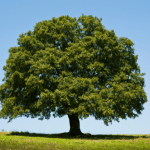 |
| Maple Tree | 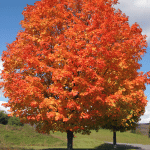 |
| Pine Tree | 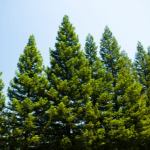 |
Please note that the provided links and images are for illustrative purposes only. You can explore further images and information through reputable botanical websites and field guides.
Different Types of Trees: A Visual Guide
In this section, we will provide a visual guide showcasing images and names of different types of trees.
1. Oak Trees
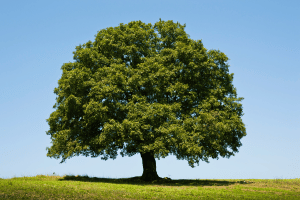
- Name: Oak Tree
- Scientific Name: Quercus spp.
- Characteristics: Strong, hardwood trees with lobed leaves and acorns. Found in various habitats across the world.
2. Maple Trees
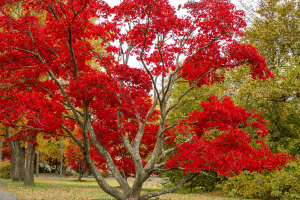
- Name: Maple Tree
- Scientific Name: Acer spp.
- Characteristics: Deciduous trees with vibrant fall foliage. Known for producing maple syrup and has a wide range of uses.
3. Pine Trees
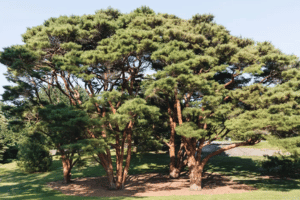
- Name: Pine Tree
- Scientific Name: Pinus spp.
- Characteristics: Evergreen conifers with needle-like leaves and distinct pine cones. Valued for their timber and used in construction and paper production.
4. Birch Trees
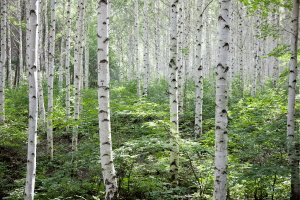
- Name: Birch Tree
- Scientific Name: Betula spp.
- Characteristics: Trees with beautiful white bark and slender leaves. Commonly found in temperate regions and has various uses in the furniture and paper industries.
5. Spruce Trees
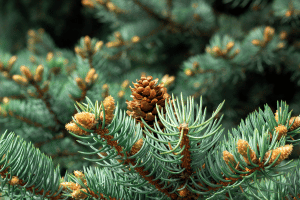
- Name: Spruce Tree
- Scientific Name: Picea spp.
- Characteristics: Coniferous trees with needle-like leaves and cones. Known for their timber and ornamental qualities.
6. Palm Trees
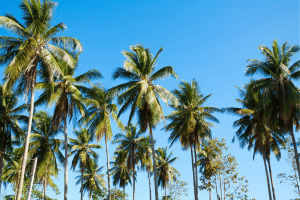
- Name: Palm Tree
- Scientific Name: Arecaceae spp.
- Characteristics: Tropical trees with large leaves, often associated with beaches and warm climates. Provide shade and visual appeal to landscapes.
7. Ash Trees
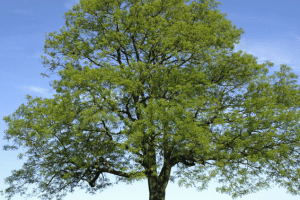
- Name: Ash Tree
- Scientific Name: Fraxinus spp.
- Characteristics: Trees with distinctive bark and compound leaves. Used in furniture, tool handles, and sports equipment.
8. Willow Trees
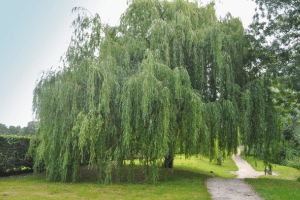
- Name: Willow Tree
- Scientific Name: Salix spp.
- Characteristics: Trees with drooping branches and slender leaves. Commonly found near water bodies and used in basketry, furniture, and medicinal practices.
9. Fir Trees
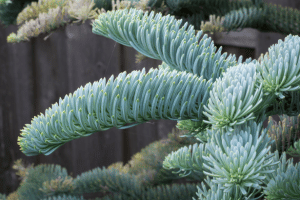
- Name: Fir Tree
- Scientific Name: Abies spp.
- Characteristics: Evergreen conifers are valued for their ornamental qualities. Often used as Christmas trees due to their fragrance.
10. Dogwood Trees
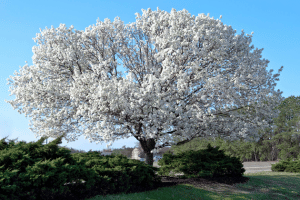
- Name: Dogwood Tree
- Scientific Name: Cornus spp.
- Characteristics: Small lovely trees known for their beautiful flowers. Commonly found in gardens and native to North America and Asia.
Please note that the images and information provided here are for illustrative purposes only. Each tree species has its unique characteristics, and further research is recommended for accurate identification.
Exploring Different Types of Trees in Florida
Because of its unique climate and geography, Florida is home to a wide variety of tree species. In Florida, you can find a variety of tree species, including the following:
1. Live Oak Trees
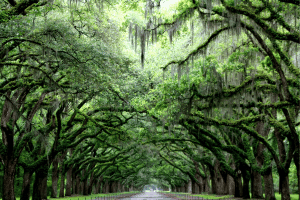
- Name: Live Oak Tree
- Scientific Name: Quercus virginiana
- Characteristics: Iconic and majestic trees with sprawling branches and evergreen leaves. They provide essential habitats for wildlife and add beauty to the Florida landscape.
2. Cypress Trees
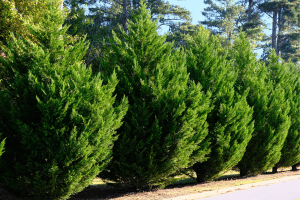
- Name: Cypress Tree
- Scientific Name: Taxodium spp.
- Characteristics: Tall trees commonly found in swampy areas. They have unique knees (protrusions from their roots) and provide habitats for a variety of species.
3. Palm Trees
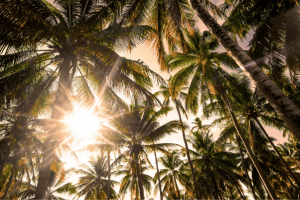
- Name: Palm Tree
- Scientific Name: Arecaceae spp.
- Characteristics: Florida is known for its abundant palm trees, including various species like the Sabal palm, Coconut palm, and Date palm. They give a tropical ambiance to the state.
4. Slash Pine Trees
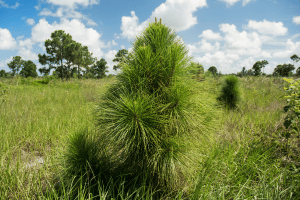
- Name: Slash Pine Tree
- Scientific Name: Pinus elliottii
- Characteristics: Fast-growing pine trees commonly found in Florida’s forests. They are valued for their timber and provide habitats for wildlife.
5. Sabal Palmetto Trees
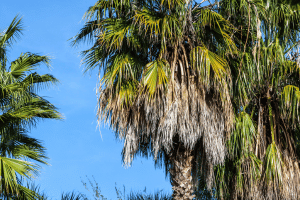
- Name: Sabal Palmetto Tree
- Scientific Name: Sabal palmetto
- Characteristics: The cabbage palm is another name for the state tree of Florida. It gives the coastal areas a classy look with its unique structure and fan-shaped leaves.
These are just a few examples of the vast array of tree species you can encounter in Florida. Exploring the diverse ecosystems and natural habitats of the state reveals a rich tapestry of tree flora.
Final Thought
Knowing about the various kinds of trees is not only interesting but also essential to the health of our ecosystem.
Understanding the names, traits, and significance of different tree species can help us appreciate nature more and make wise decisions to preserve and protect our natural resources.
This guide has given you important insights into the different varieties of trees, whether you’re an outdoor enthusiast, a gardener looking for ideas, or just inquisitive about the world around you.
You may improve your knowledge of trees and help to preserve our natural heritage by consulting the visual guide and using the identifying recommendations.
So, let’s continue to explore, learn, and celebrate the beauty and benefits of different types of trees. Remember to take a moment to appreciate the trees that surround you and the countless ways they enrich our lives.